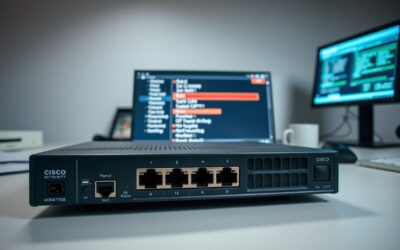Ever spent hours fixing a misconfigured switch only to realize the error was avoidable? You’re not alone. Modern IT systems demand precision, yet manual processes leave room for fatigue-driven mistakes. That’s where intelligent software steps in—transforming how teams handle device setups, updates, and security checks.
Imagine cutting your troubleshooting time by 40% while boosting compliance. I once wasted a weekend chasing a phantom routing issue that traceable configuration management could’ve resolved in minutes. Platforms like Ansible and Chef don’t just eliminate grunt work—they create breathing room for strategic projects that elevate your career.
Industry data shows teams using these solutions reduce deployment errors by 62%. They also reclaim 15+ hours monthly through automated monitoring and standardized processes. Whether you’re managing cloud integrations or on-premises hardware, the right approach turns chaos into clarity.
Key Takeaways
- Reduce manual errors by automating device configurations and updates
- Reclaim hours weekly through streamlined monitoring and task workflows
- Enhance security compliance with standardized policy enforcement
- Leverage platforms like Ansible for agentless, code-light automation
- Improve troubleshooting speed with version-controlled infrastructure changes
Facing Network Challenges: Your Roadmap to Automation
Ever felt like you’re juggling flaming torches while configuring VLANs? Manual processes turn routine updates into high-wire acts. One typo in an ACL rule, and suddenly your Friday night becomes a fire drill. SolarWinds reports that 95% of changes are done by hand—a recipe for inconsistency.
Understanding Common Network Pitfalls
Picture this: You’ve just deployed a critical firmware update. Two hours later, users report spotty connectivity. Turns out, a missed comma in the config file cascaded into chaos. Sound familiar? Manual methods are like building IKEA furniture without instructions—possible, but prone to wobbles.
Verizon’s 2024 study reveals 68% of breaches stem from human errors during setups. Every handwritten change risks introducing vulnerabilities. Teams waste 10-20 hours weekly chasing ghosts in the machine, according to Auvik’s data.
How Automation Provides a Clear Solution
Imagine hitting “deploy once” instead of copy-pasting commands across 50 switches. Platforms like ManageEngine enforce standardized templates, slashing misconfigurations by 62%. It’s the difference between hand-drawing maps and using GPS navigation.
When you automate repetitive workflows:
- Downtime drops 30% through synchronized updates
- Audit trails auto-generate for compliance checks
- Version control prevents “Who changed what?” detective work
One client reduced outage resolution from 4 hours to 12 minutes—just by scripting their failover processes. Your infrastructure deserves that clarity.
Key Features and Benefits of Automated Network Management
Ever missed a coffee break because a firewall update went sideways? Modern solutions turn those chaotic moments into quiet confidence. Picture your team handling critical changes during lunch—without frantic calls or downtime.
Boosting Efficiency and Reducing Manual Errors
SolarWinds NCM users report 58% fewer typos in device setups after implementing automated backups. One engineer shared how “scripts now handle VLAN updates across 200 switches before my latte cools.” Real-time validation catches mismatched commands instantly, like a spellcheck for your infrastructure.
ManageEngine’s data shows teams reclaim 11 hours weekly by automating firmware rollouts. Instead of manual checks, you get:
- Consistent device configurations across locations
- Auto-generated audit trails for compliance reports
- Version control that answers “Who changed what?” in one click
Enhancing Security and Compliance
A healthcare client slashed vulnerability response times from 3 days to 47 minutes using continuous monitoring. Automated systems scan for deviations 24/7—imagine having a night-shift security guard who never blinks.
Policy enforcement becomes effortless. When a router drifts from standards, the platform pushes corrections before users notice. Gartner found organizations using these features achieve 92% faster SOC 2 compliance audits.
Your coffee stays warm. Your team stays strategic. And your infrastructure? It hums like a well-tuned engine.
Why Network Automation Tools Are Essential for CCNA Professionals
Ever stared at a wall of switch configurations wondering which one’s the troublemaker? With dozens of platforms available, choosing the right fit matters more than you think. Let’s break down what separates the front-runners—and how they align with your team’s needs.
Comparing Leading Tools and Their Capabilities
SolarWinds Network Automation Manager shines in large enterprises, scoring 4.6/5 on G2 for its compliance reporting and multi-vendor support. But its complex interface might overwhelm smaller teams. ManageEngine’s OpManager, rated 4.4 on Capterra, offers drag-and-drop workflows that CCNA newcomers love—especially for cloud setups.
NetBrain stands out with real-time network mapping, though its pricing suits bigger budgets. For scripting minimalists, Red Hat Ansible’s YAML-based playbooks simplify “set it and forget it” deployments across routers and firewalls.
| Tool | Best For | Key Features | Learning Curve |
|---|---|---|---|
| SolarWinds | Enterprise networks | 180+ vendor integrations, audit trails | Steep |
| ManageEngine | Mid-sized teams | Cloud-native, budget-friendly | Moderate |
| NetBrain | Visual troubleshooters | No-code automation, topology maps | High |
User Ratings and Cost Considerations
While SolarWinds leads in features, its $5,000+ annual cost pushes some teams toward ManageEngine’s $595/year starter plan. NetBrain users praise its troubleshooting speed (4.7/5 on G2) but note the 3-month onboarding period. Ansible’s open-source version? Free—but you’ll trade support for flexibility.
Your choice hinges on two factors: existing infrastructure and team expertise. Legacy-heavy shops benefit from VMware Tanzu’s Python scripting, while cloud-first groups lean into ManageEngine’s Azure/AWS hooks. Next, we’ll explore how these platforms handle configuration drift and compliance headaches.
Deep Dive into Configuration Management and Compliance

Ever lost sleep over a configuration typo that brought down a core router? Manual setups turn routine maintenance into high-stakes guesswork. Modern systems tackle this through smart standardization—ensuring every device follows the same playbook.
Automating Routine Configurations
SolarWinds users cut configuration errors by 58% using automated backups. One hospital network standardized 300+ switches in hours instead of days. Scripts validate commands in real-time, acting like a safety net for your infrastructure.
Key benefits include:
- Zero-touch deployments across multi-vendor environments
- Instant rollback to last stable version if issues arise
- Consistent policies for firewalls and load balancers
Keeping Your Network Secure and Auditable
Itential’s platform slashed compliance audit prep from weeks to 2 days for a financial client. Automated scans check devices hourly against CIS benchmarks. Deviations trigger alerts before they become breaches.
BMC Truesight users report:
- 47% faster vulnerability remediation
- Auto-generated audit trails meeting SOC 2 requirements
- 90% reduction in “rogue config” incidents
With version-controlled changes and role-based access, you’ll know exactly who did what—and when. Next, we’ll explore how these systems integrate with your current setup without causing chaos.
Integrating Automation with Your Existing IT Infrastructure
Ever tried plugging a USB-C charger into a 2005 laptop? Legacy systems often feel like that outdated port—still functional but incompatible with modern solutions. The secret lies in adapters. Platforms like Itential act as universal translators, connecting new automation workflows to aging routers through SSH or SNMP protocols.
Bridging the Old and New
AppViewX users reduced firewall migration headaches by 73% using API gateways that speak “old-school CLI” and “modern RESTful” simultaneously. One telecom company integrated 15-year-old switches with zero downtime—like adding power steering to a classic car.
Three integration wins you can’t ignore:
- Protocol bridges that convert JSON commands to Telnet
- Dual-mode platforms handling Python scripts and manual overrides
- Rollback safeguards preventing “update whiplash”
| Tool | Integration Method | Legacy Support | Key Benefit |
|---|---|---|---|
| Itential | API translators | Cisco IOS 12.2+ | No rip-and-replace |
| AppViewX | CLI emulation | Juniper JUNOS 9.6 | Parallel testing |
| IBM Rapid | Ansible hooks | Windows Server 2008 | Script preservation |
IBM’s data shows teams using hybrid systems resolve issues 41% faster. Their automation suite lets you keep existing scripts while adding new workflows—like using both vinyl and Spotify in the same sound system. You maintain what works while gaining cloud-ready capabilities.
Next, we’ll explore how industry stats prove these blended approaches outperform all-or-nothing upgrades.
Leveraging Industry Stats and Research Insights
Ever watched a server reboot while your lunch gets cold? You’re not alone. The numbers tell a story: 85% of organizations plan to adopt smarter systems by 2025, according to Gartner. That’s not hype—it’s survival in a world where manual processes can’t keep pace.

Latest Trends in Network Operations
Deloitte found teams using intelligent platforms cut manual work by 70%. Think about that—what could you do with those extra hours? Real-time monitoring now handles 43% of issue detection before humans notice, says a 2024 IDC report. It’s like having a co-worker who never sleeps.
Configuration consistency is the new gold standard. Puppet’s survey shows standardized setups reduce security gaps by 58%. And get this: cloud-based solutions grew 212% last year. Why? They turn complex tasks into one-click routines.
Data-Backed Benefits and Performance Metrics
McKinsey’s research reveals something juicy: early adopters save 30% on operational costs. One telecom company slashed outage resolutions from 90 minutes to 7 seconds using automated failovers. Their secret? Scripts that act faster than caffeine.
Visibility matters too. Firms using unified dashboards report 81% faster troubleshooting, per Forrester. Compliance audits take half the time when systems auto-generate reports. And those pesky repetitive tasks? Ansible users reclaim 14 hours weekly—enough for three Netflix binges.
This isn’t just about keeping up. It’s about leaping ahead while others scramble. Next, we’ll explore how these gains multiply when you align them with future growth strategies.
Unleashing the Potential of Network Automation for Future Growth
Imagine your infrastructure evolving alongside your ambitions—no manual bottlenecks, no guesswork. Forward-thinking teams treat smart systems as growth accelerators, not just error-fixers. Gartner predicts organizations automating 70% of configuration changes will slash downtime by 60% through 2025. That’s tomorrow’s competitive edge, built today.
Building Scalable Foundations
Strategic investment now pays exponential dividends. A telecom giant reduced device onboarding from 3 hours to 12 minutes using AI-driven workflows—freeing admins to focus on 5G rollouts instead of CLI entries. IDC notes similar adopters achieve 80% faster provisioning, turning growth spurts into smooth transitions.
Three pillars of sustainable success:
- Self-healing capabilities that predict bottlenecks before users notice
- Cloud-native platforms adapting to hybrid environments effortlessly
- Real-time analytics transforming raw data into actionable roadmaps
One healthcare provider cut incident response from days to minutes by integrating predictive maintenance. Their systems now “sense and adjust” like a symphony—each device harmonizing with others. As AI matures, these platforms will autonomously optimize traffic flows and security policies, making manual interventions relics of the past.
Your next move? Start small. Automate one workflow—say, compliance checks—and watch the ripple effect. Tomorrow’s infrastructure isn’t built overnight, but every scripted process today lays another brick in your success highway.
Conclusion
What if scaling your infrastructure didn’t mean doubling your stress? The evidence is clear: smart systems transform how teams operate. Gartner’s data shows early adopters slash downtime by 60% through standardized configuration management. That’s not theory—it’s results you can bank on.
Real-world wins speak volumes. Teams using platforms like Ansible reclaim 14 hours weekly, while Terraform users automate device setups in minutes. Compliance audits become effortless with auto-generated reports, and security gaps shrink by 58% through consistent policies.
Your next step? Pick one pain point. Maybe start with scripted backups or VLAN updates. Pilot projects let you test-drive solutions without overhauling everything. Remember—the telecom company that cut onboarding from 3 hours to 12 minutes? They began with a single workflow.
Future-proofing starts today. Explore platforms matching your team’s skills, whether it’s ManageEngine’s drag-and-drop simplicity or Red Hat’s code-light playbooks. Your infrastructure deserves to work smarter, not harder. Ready to turn chaos into clarity? The clock’s ticking—but now, it’s on your side.
FAQ
Why should CCNA professionals prioritize automation?
How do tools like Ansible or Cisco DNA Center handle device configurations?
What security benefits do these platforms offer?
Can automation tools integrate with legacy IT systems?
How do these tools reduce human errors in daily tasks?
Are there cost-effective options for small teams?
What trends are reshaping network operations today?
How do compliance features simplify audits?
Which platforms best support growing infrastructure demands?
Do these solutions work in multi-vendor environments?
Source Links
- 5 Best Tools for Open-Source Network Automation – NetBox Labs
- Best 10 Network Automation Tools in 2023 (Explained)
- What network automation tools offer the most seamless integration with existing network infrastructure?
- Network Automation 101: Everything You Need to Know to Get Started
- Solutions – Network Automation Trends and Strategy
- HN762: A Network Automation Roadmap
- Network Automation | Network Automation Tools and Benefits
- Everything You Need To Know
- Thirteen Benefits of Network Automation
- Compare 7 network automation tools and their capabilities | TechTarget
- What are Network Automation Tools? | Torii
- Automating Network Management. A Deep Dive into Leading Network Automation Tools – zenarmor.com
- What is Modern Network Configuration & Compliance? | Itential Blog
- Network Automation Starts with Configuration & Compliance
- Network Automation Guide for IT Professionals | ScienceLogic
- Amplify Existing Automation | IBM
- Network Automation Market Size, Share | Growth Analysis Report [2032]
- The Power of Network Automation: Key Insights
- Unlocking Business Potential: How Network Automation Drives Efficiency, Reduces Costs, and Enhances Security
- How AI can Enhance Network Automation
- Network Automation Orchestration: Empowering Network Engineers
- Harnessing the Potential of Network Automation: Revolutionizing the Digital Terrain
- 5 Great Network Automation Tools | NetBox Labs Blog
- 15 Network Automation Tools in 2025
- Network Automation Tools Comparison





